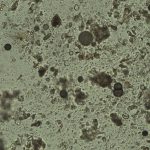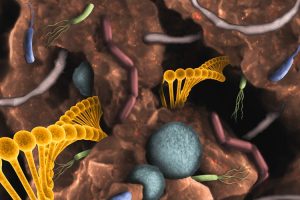Pathogen-Reducing Compost
January 14, 2020
© 2020
Benefits of compost are widely known: 1) enhances water holding capacity, soil structure,  organic matter, drainage, and nutrient holding capacity of soil, 2) provides a source of beneficial microbes, 3) decreases both inputs (to your garden) and outputs (from your garden), a plus for sustainability, and, 4) reduces fertilizer and pesticide use.
organic matter, drainage, and nutrient holding capacity of soil, 2) provides a source of beneficial microbes, 3) decreases both inputs (to your garden) and outputs (from your garden), a plus for sustainability, and, 4) reduces fertilizer and pesticide use.
However, did you know that well-made compost has the ability to reduce pathogens and enhance plant growth?
An extensive research study of 120 bioassays, involving 18 composts and seven pathogens, found positive disease suppression in 54 percent of the treatment combinations, a disease stimulating effect only rarely (3%), and no effect in 43 percent of the treatment combinations (Termorshuizen et al., 2006).
Other studies have shown that “backyard” compost is superior to the commercial product, possibly due largely to richer and varied starting materials, plus a more relaxed thermophillic phase (wherein temperatures are sanitizing but lower than those recorded in commercial composts). Backyard composting presented higher counts of bacteria, actinomycetes, and fungi. It also shows higher percentages of isolates producing extracellular enzymes which allow the breakdown of tough substrates, including polyethylene!
Although the studies show the efficacy of compost, no one has come up with the perfect recipe or management strategy to combat a particular soil pathogen. This is because the soil microbial community is so dynamic and complex. Quality control tools are also lacking.
Still, we know from research that microbial organisms in compost are able to reduce pathogens my means of: direct antagonism (antibiotic production and direct parasitism), predation, competition for resources, enzyme production, and, induced resistance in plants – through signaling networks and hormones.
Sat, Feb 1, 10-12, Work Party
Sat, Feb 1, 1-3, PRUNING CLASS
Sun, Feb 16, 2-4, Work Party
Sat, Mar 7, 10-12, work party
Note, compost is more effective as a pathogen prevention method than when used as a management strategy for some existing soil or plant pathogen. Elaine Ingham, veteran soil scientist, points out that compost and soil should be colonized with a sizeable and diverse body of microbes. “There are only so many seats at the table. If the good guys are already there, the bad guys are turned away.”
Who are these microbial actors who play such a beneficial role in a garden? It’s bacteria, fungi, protozoa, and nematodes, none of which can be seen with the naked eye. There are millions of microbes in a gram of compost and hundreds of thousands different species. In fact, it’s the diversity of players that makes good compost a pathogen suppressor.
Commercial composts can differ widely in their suppressive effects and can vary as to which pathogens are diminished. However, commercial composts can meet the objective of adding organic matter to the soil. In contrast, the special compost that you can produce with backyard composting, using correct temperature, moisture, aeration and curing processes, will yield a compost that you can use sparingly as an inoculum throughout your garden. It will jump-start good soil biology and maintain nutrient cycling, creating an environment fostering pathogen-suppressive soil.
Next up – A template on making a thermal compost.
Also, watch the FreewayEstates.org calendar for a hands-on thermal composting class, coming in early May, 2020
Ruth
References:
Hadar & Papadopoulou, 2012 – Suppressive Composts: Microbial Ecology Links Between Abiotic Environments and Healthy Plants DOI: 10.1146/annurev-phyto-081211-172914
Vaz Moreira et al., 2008 – Diversity of Bacterial Isolates from Commercial and Homemade Composts. DOI: 10.1007/s00248-007-9314-2
Welgarz et al., 2018 – Microbial diversity and nitrogen-metabolizing gene abundance in backyard food waste composting systems DOI: 10.1111/jam.13945
Fayolle , L., 2006 – Eradication of Plasmodiophora brassicae during composting of wastes
https://bsppjournals.onlinelibrary.wiley.com/doi/full/10.1111/
Cangelos, G, 2014, Dead or Alive: Molecular Assessment of Microbial Viability
https://aem.asm.org/content/80/19/5884 DOI: 10.1128/AEM.01763-14




Leave a Reply
Want to join the discussion?Feel free to contribute!